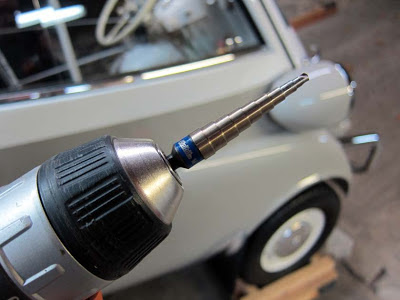I now have my hi/low beam and turn signal switches installed.
The Isetta's wiring diagram is a little vague about which terminals each wire is connected to, so I found myself referring to pictures I had taken while disassembling the car for help rewiring the switches.
The left switch is the hi/low beam which has three wires running to it. The top two terminals get the yellow (71) and white (73) wires.
The bottom terminal gets the yellow/white (72) wire.
The right switch is the turn signal switch which has six wires running to it. The top side terminals get the blue/yellow (78), grey/black (57), and green/black (58) wires.
The bottom side of the switch gets the red/black (79), green/white/black (80), and red/white/black (81) wires
You can see the wires going to the switches are all slightly different lengths. This is pretty important, because there is not much room inside the housings to have any excess wire. I probably had my switches on and off three or four times tweaking the lengths of the wires so that everything fit in the housings neatly.
I can't remember where I read it, but if you need to replace the plastic sleeve between the housings for the switches, there is an easy fix available at virtually any hardware store.
All you need is a 1-1/2" diameter plastic flanged tailpiece for a drain. I picked this one up for under $2.00.
Next all you need to do is to cut it to the correct length and then make a vertical slit in it and voila!
I've also finished connecting the wiring from the dash to the terminal block on the wheel well.
I've also installed the speedometer cable.
I also recently installed the front stone guards and mud flaps.
The stone guards I purchased didn't exactly lay down flat on the curve of the Isetta's body and the holes didn't quite line up with the holes that were pre-punched in the mud flaps. If the stone guard laid flat on the contour of the body, it would be easy to mark the location of the holes that need to be drilled, but since it didn't lay flat, I had to do a screw at a time gradually pulling it flat against the body. I found there was an order of drilling the holes that worked best to prevent creating spots where the stone guard did not pull tight against the body. Hole number 1 should already exist in the wheel well of most Isetta's. I started with attaching the stone guard and mud flap at this point on the inside bottom of the wheel well. I next positioned the stone guard and mud flap in the approximate correct position on the wheel well and marked the mud flap where holes needed to be punched. After punching new holes in the mud flap, I reattached the stone guard and mud flap with screw number 1. I then adjusted it to the correct position on the wheel well and drilled hole number 2. After installing screw number 2, I pressed the stone guard flat against the body and drilled hole number 3 and installed the screw pulling it flat against the body. I then repeated the process with holes 4 and 5.
One other thing I would recommend when drilling holes in sheet metal are Unibits which are also referred to as stepped drill bits. Unibits are the absolute best for drilling clean holes in thin sheet metal. They're also great for enlarging existing holes. This is a small metric size Unibit in 1mm increments up to 12mm, but they are commonly available in many sizes that can drill holes as large as 1-3/8".



















No comments:
Post a Comment